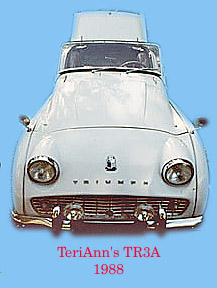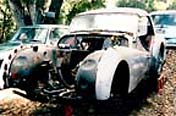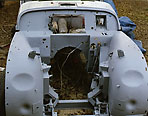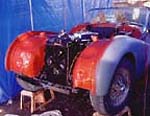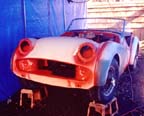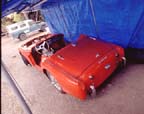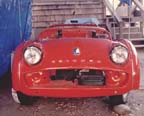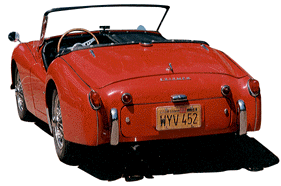
LINKS TO FEATURED PAGES:
![]() TRIUMPH
Contents page > Known history
TRIUMPH
Contents page > Known history
|
Triumph TR3A, commission number TS75519L was born in May of 1960 and sold into the United States as a 1961 model. She came from the factory signal red. She was equipped with the optional black leather upholstery with white piping. She also had a white hood and side curtains. I have been able to piece together parts of her history from old receipts and made speculations based upon her condition. By all indications, she was used hard, poorly maintained and spent a lot of time sitting out in the rain during the first 17 years of her existence. As a direct result,she has spent only a few years on the road during her following 20 years. The oldest documentation I have for her is a pile of receipts from a previous owner, Bud Clark of Scotts Valley California. It appears that Bud owned the Triumph between the fall of 1976 and Fall of 1980. The car appears to have been a very poorly maintained state when Bud purchased her. During the first six months of ownership, he had the steering worked on, all the hydraulics rebuilt, the fuel tank patched,the radiator patched, the entire exhaust system replaced, the water pump and timing chain replaced. The car had her seats recovered about that time or earlier. She still had her original factory signal red body colour and had to have been heavily rusted. The last repair receipt I have from the time that Bud owned the car was dated July, 1978 and was for unfreezing the pistons and replacing the rings. Either the car did not have problems between then and the Fall of 1980 or she was taken off the road. In the Fall of 1980 the car was purchased by Nelson Herbert of Santa Cruz. Nelson owned the car between Fall 1980 and the Fall of 1986 when I purchased her. I do not know if Nelson drove the car much if any. He took her off the road soon after purchasing her to "restore" her. The restoration consisted primarily of wire brushing the rust, laying fiber glass over the rust through holes and painting her a Chevy white. The engine bay and boot were painted flat black. The paint was applied three or four years before he sold the car. He could not sort out the various mechanical problems and kept it stored in a garage. Eventually he lost interest and put her up for sale. Sometime during the summer of 1986, I decided that life was too short not to drive a roadster. After looking around I decided that Triumph produced the best cars that would fit in my limited budget. I started looking around for an affordable Spitfire after coming to the conclusion that the Triumph TRs were out of my price range. During the fall of 1986 I found a TR3 listed for sale in the Hewlett Packard employee paper. I called and made an appointment to see her. I first saw her sitting in a garage in Scotts Valley. She was coated with a heavy layer of dust and miscellaneous objects. A rock behind a rear wheel kept her from rolling out the driveway. Her interior looked very worn. The side and rear interior trim caps were missing. The paint and body looked near perfect . According to Nelson, the car had only been out of a garage to move from one house to another since she was painted a few years earlier. He said he didn't know enough to get the engine running reliably and had lost interest over time. We removed the debris, added some petrol, squirted some ether down the throats of the SUs a fired up the engine. She wouldn't idle except with the choke half out and the idle speed cranked up. The brakes took to two pumps to work. I backed her out of the driveway and took her up and down the street. The gears all seemed to work and the engine seemed OK except for her idle. I noticed that the steering wheel did not return without help. All it took was a short turn behind the steering wheel looking down her long bonnet. I was hooked bad and found myself madly in love. US$ 1,000 changed hands and I drove her home grinning from ear to ear. Just as I got home she blew a rear wheel cylinder. I knew I had a lot of work to do on her, but the body was in excellent shape so it wouldn't be too bad. When I cleaned out the float bowls in the SUs and added a fuel filter I discovered she started easily and idled smoothly. After I rebuilt her hydraulic system she was well on her way to becoming a driver. I noticed that she was making a clacking noise under load that sounded high in the engine. I pulled the valve cover and checked the valve train. I discovered a bent push rod. I also noticed that the rocker arms were loose on the rocker shaft. I purchased a new rocker shaft, all new adjuster screws and had a machine shop install new rocker arm bushings and resurface the end of the arms. That did not eliminate the high end clacking sound under load. I had just about decided that I had a bad small end bearing except there was something causing a push rod to go out of adjustment frequently. After looking at it and adjusting it frequently over a few day period I finally saw a line of oil along one side of the push rod's top cup. A close examination showed a crack along one side of the cup. The push rod looked fine as long as there was no load on it. Under load the crack opened up creating a large clearance. I replaced all the push rods and eliminated the clacking noise. I have no idea what was done to the car to bend one push rod and crack the cup of another. I wasn't sure I wanted to know. But I did know that I now had a functional driver TR3A! And Drive it I did!
During the time I was trying to get the car into running condition, I was asking a lot of questions on the rec. auto newsfile. I received an e-mail from a guy on the East coast named Dale. He said he was starting a British car e-mail list and asked me if I wanted to join. I said yes and became one of the founding members of the first British car related e-mail list. Also in early 1987 I also joined the Triumph Travelers Sports Car club and attended a lot of events in my TR3. I had a wonderful time touring around in my Triumph. But over the next few years I noticed that bubbles were popping out through the paint along the bottom of the body and the engine was going through more and more oil. I had the rear end rebuilt and replaced a worn out ring and pinion. In early 1989, the tired transmission was replaced with a newly rebuilt TR4 all syncro transmission with overdrive. The steering was still stiff and uncertain and the engine was going through more and more oil but I was still having a wonderful time. By by mid-1989 the #3 spark plug was oil fouling after about 50 miles. On long club trips, I had to stop every fifty miles or so and swap out the # 3 spark plug. I decided it was about time to take her off the road for a few months to get the engine rebuilt. At Triumphfest '89 I started purchasing parts for an engine rebuild. I thought that while I was at it I should go through the front suspension and renew the interior. The 1989 Los Gatos Christmas parade was the last club event she participated in before I took her off the road in January for a few months of refurbishing. The goal was to have her back on the road in May or June so I would be able to catch most of the season's club events. When I started taking things apart I discovered severe rust underneath and the job grew another notch. When I put my hand through the rear valence while I was doing some light colour sanding, I decided that all the paint had to come off to see what was underneath.
My engine & suspension rebuild plus interior renewing grew into a full scale down to bare metal car restoration project. I'll not go into the project here as my restoration project from hell is documented on another web page. Suffice it to say I learned a whole lot about late TR3As, having professional work performed by the lowest bidder and tenacity during the duration of this project.
My TR3A made his first drive in 1999. His first club run was the Triumph Traveler's Santa Cruz winery tasting trip. I had just started ironing out the bugs in the system so naturally the starter motor stopped working early on the trip and I needed a push start to leave the last two thirds of the wineries. The problem ended up being a bad starter motor ground caused by a painted starter motor ring on the engine block and a painted starter motor. The cure was stripping the paint off both mating surfaces. Since the 3 was up and running I started spending more time driving plus a little time gradually finishing the restoration. Ten years after being taken off the road for a spruce up, my TR3A is on the road stalking the new generation of modern roadster.
|
|
© 1997 - 2017 TeriAnn Wakeman. All rights reserved.

